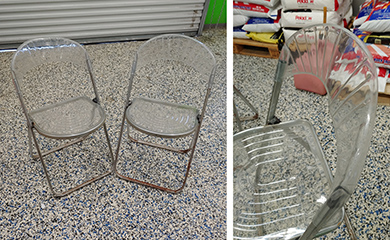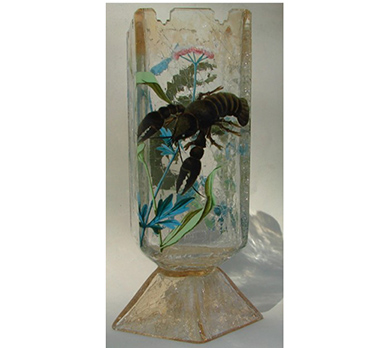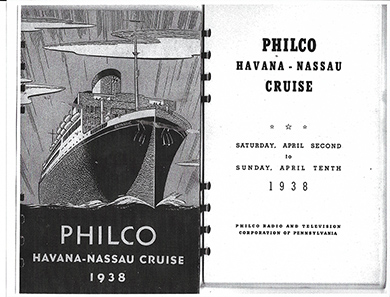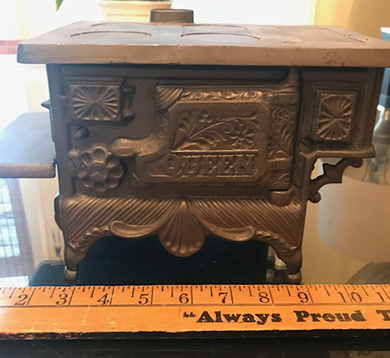 |
|
|||
 |
 |
|||
RINKER ON COLLECTIBLES — Column #1747 Copyright © Harry Rinker, LLC 2020 Questions
and Answers
QUESTION: While checking out a dumpster at a self-storage facility, I found a set of four, metal frame folding chairs. The back consisted of a demilune, clear, ribbed impressed piece of plastic (not Lucite). The saddle-shaped seat also was a piece of clear, ribbed impressed plastic. The plastic seems to have a hint of light green when the light hits it. The bottom of the front frame was marked ‘MOD DEP / Made in Italy.” My Google research failed to turn up an exact match. I did find similar Italian designer chairs that closely resemble my chairs. They sell for a lot of money. The frames have rust on the bottom. Can they be refinished? If not, should I chuck them back in the dumpster? – LR, Email Question 
ANSWER: Usually, I do not become involved in an email exchange when a reader submits a question to “Rinker on Collectibles.” In this instance, the initial email only included two pictures and a two-word query: “Hello, thoughts?” The pictures of the chairs intrigued me. A wish to know how the reader acquired the chairs and what she knew about them began a three-day back and forth email exchange. Her passion and enthusiasm were apparent and contagious. The photographs accompanying the first email indicated the folding chairs had a strong mid-century Modernist design influence. I found several mid-century modern Lucite folding chairs by Italian designers. The first was a design attributed to Castelli and manufactured by G. Piretti and the second a folding Lucite and chrome chair by Plia. Neither matched the design of the reader’s chairs. Antiques and collectibles require an apple to apple comparison to achieve a match. “Close, but no cigar,” an old phrase, does not work in the antiques and collectibles business. Woulda, coulda, and shoulda is a common mistake many make. The reader’s set of folding chairs appears to be a knockoff of Italian modernist designers and manufacturers of folding chairs. The frames are not high quality. The back and seat are made from an inexpensive molded plastic as opposed to Lucite. Persistence counts when it comes to doing antiques and collectibles research. I tried several WorthPoint searches without success. The reader also persisted. Three days into our email exchange, she found a match using an eBay “mid-century folding chairs” search. A seller was offering a pair for $87.00. They were in better condition, and the seat and back were an olive-green (not clear) molded plastic. The reader sent me the eBay image but not the URL. I tried to find it but was unsuccessful. My analysis of the images sent by the reader is that the cost to restore the chairs in terms of removing the rust and re-plating the metal is prohibitive. It would cost more than the finished chairs were worth. At the same time, I am advising against returning the chairs to the dumpster. Instead, secure a rust inhibiting silver paint and apply it to the frames. This will make the chairs presentable and functional. Since the chairs already have a sense of pseudo-class, painting will improve the perceived value. When done, your modernist-style set of four folding chairs will be worth around $100.00. QUESTION: I recently bought a piece of crackle glass to give to my mother as a birthday present. It has a raised base of four trapezoid sides, a square, castle tower-like body, with two drop cutouts on each of the four edges of the top. Painted on the glass is an image of a lobster swimming among ocean foliage. What information can you provide about my vase? – KC, Berry, KY, Email Question 
ANSWER: Crackle, also known as craquelle glass, ice glass, or overshot glass, is a glass finish that produced a cracked or crackled texture to the surface. The surface is cracked by immersing the glass in cold water. The shock causes the glass to crack. The piece is then reheated to smooth and strengthen the surface. The process dates back to 16th century Venice. European glass makers continued to use the technique through the 19th century. Crackle glass was extremely popular from the 1930s through the 1970s. Dozens of American glass manufacturers such as Blenko, Bischoff, Fry, Imperial, Kanawha, Pilgrim, and Rainbow produced it. Crackle glass still is being produced in China and Taiwan. The shape of your vase and painted decoration suggest a European origin, probably around the turn of the 20th century. Stan and Aelene Weitman’s “Crackle Glass Identification and Value Guide,” published by Collector Books in 1995, and Judy Alford’s “Collecting Crackle Glass,” published by Schiffer Books in 1997, are excellent reference sources to learn more. Like so many readers who email or send questions, you did not share what you paid for the piece. I am curious. When you read the column, send me an email to let me know what you paid and where you acquired it. t QUESTION: I have a booklet documenting a Philco Radio and Television Corporation of America distributors’ incentive cruise to Havana and Nassau from April 2 to April 10, 1938. The trip begins with a train ride from Philadelphia to New York and then a transfer to Pier 90 to board the “M. V. Britannic.” The booklet contains the full itinerary and passenger list. Does it have any value? – SD, Lansdale, PA, Email Question 
ANSWER: The “M. V. Britannic,” a transoceanic liner, was owned by the White Star Line before its merger with the Cunard Line in 1934. The ship was used for the London-New York line and later Mediterranean cruises. Obviously, it also was available for cruises to Cuba and Nassau during the latter part of the Depression. While your booklet has some appeal to Philco collectors, its primary market is to ocean liner collectors, especially those focusing on Cunard Line and White Star ships. WorthPoint.com has over 300 listings for “M. V. Britannic” items. Although I did not find an exact match for your promotional cruise booklet, I found several comparable items. The value of your booklet is between $20.00 and $30.00. QUESTION: I have a miniature cast iron, Queen woodburning stove that came from my wife’s parents. They loved going to auctions and I suspect this is how they acquired it. I have been told the stove is a salesman’s sample that would be shown to customers to demonstrate the features of the full-size model. What is the stove worth? – RG, Bellwood, PA, Email Question 
ANSWER: Your stove is a child’s toy and not a salesman’s sample. I found no evidence there was a full-size, “Queen” trademarked wood burning stove or a full-size wood burning stove that contained the same features as your stove. Several American cast-iron toy manufacturers made “Queen” trademarked child’s cast iron stoves. In addition, cast iron reproductions of “Queen” cast iron stoves dating from the post-1945 era are a glut on the secondary market. The good news is that the quality of the castings on your stove suggest it was made before 1915. Your stove is incomplete. It is missing the exhaust flue and the pots and pans that were part of its initial purchase. While these missing pieces may seem insignificant, they are not – especially the exhaust flue. A fair secondary market value for your stove as it exists is between $60.00 and $80.00, a steep decrease in value from what a similar stove would have realized 20 years ago. Harry L. Rinker welcomes questions from readers about
collectibles, those mass-produced items from the twentieth and twenty-first centuries.
Selected letters will be answered in this column.
Harry cannot provide personal answers.
Photos and other material submitted cannot be
returned.
Send your questions to: Rinker on Collectibles, 5955 Mill
Point Court SE, Kentwood, MI 49512.
You also can e-mail your questions to
harrylrinker@aol.com.
Only e-mails containing a full name and mailing address
will be considered.
|
||||